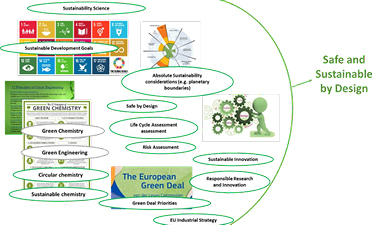How SETAC Europe Is Contributing to the Chemicals Strategy for Sustainability
Annegaaike Leopold, Caldris Environment BV; Michelle Bloor, University of Glasgow; Hans Sanderson, Aarhus University; Bruno Campos, Unilever; Ksenia Groh, Eawag – Swiss Federal Institute of Aquatic Science and Technology; Paul Thomas, KREATiS; and Leo Posthuma, RIVM
In April of this year, SETAC Europe became a member of the European Commission’s High-Level Roundtable (HLRT) for the Implementation of the Chemicals Strategy for Sustainability (CSS) towards a toxic free environment. This position provides SETAC members with the opportunity to forward the realization of the objectives of the CSS through the newly established SETAC Europe HLRT Sounding Board, populated with SETAC members. Annegaaike Leopold was appointed by the SETAC Europe Council to represent SETAC Europe at the roundtable itself, and subsequently, SETAC members were invited to apply to become SETAC Europe Sounding Board members. Members appointed to the SETAC Europe HLRT Sounding Board are two SETAC Europe Council members, Michelle Bloor (academia) and Bruno Campos (business); four members-at-large, Leo Posthuma (government), Ksenia Groh (academia), Hans Sanderson (academia) and Paul Thomas (business); one SETAC Europe Executive Committee member, Mirco Bundschuh (academia); and Roel Evens, science project manager of the SETAC Europe office.
In October 2020, the European Commission published the “Chemicals Strategy for Sustainability Towards a Toxic Free Environment.” This policy document is accompanied by an 85-point action plan and European Commission staff working documents, used for the actual implementation, which has already started with great speed and determination. This strategy, if successful, will by 2050 have created a sustainable chemicals market while providing a high level of protection for the health of EU citizens and the environment. In addition, the CSS aims to set the example for the sound global management of chemicals, through international leadership and cooperation with third countries. This makes it a strategy to which SETAC members from around the world can contribute.
The HLRT was established by the European Commission to identify obstacles to implementing the Chemicals Strategy (technological, social, cultural, economic, etc.) and to find solutions to overcome them. There are 33 members at the roundtable including ten NGOs or civil society organizations; ten chemical companies, including CEFIC, the European Chemical Industries Council; eight scientific organizations, one of which is SETAC Europe; three international organizations, the World Health Organization, the UN Environment Programme and the Organisation for Economic Co-operation and Development; and one EU member state (the state that has the presidency of the European Council at the time of a roundtable meeting).
In addition to a permanent representative at the HLRT, each organization is allowed to nominate one or more so-called “Sherpas,” or people willing to help do some of the heavier preparatory work. The members of the SETAC Europe Sounding Board have therefore become members of this Sherpa group on behalf of SETAC Europe. The SETAC Europe Sounding Board is an effective way for SETAC to address the historical issue it has had with the concept of one person’s voice representing an opinion on SETAC’s behalf. Since the broader sounding board group is better positioned to collect and represent the opinions of the tripartite SETAC membership, this approach offers an effective and achievable solution for such situations. The establishment of a sounding board was first implemented for SETAC’s work with the European Food Safety Authority (EFSA; SETAC is the academic representative on the EFSA Stakeholder Bureau). The mandate of the SETAC Europe HLRT Sounding Board is to be a platform for consultation, reflection and integration of perspectives within an appointed tripartite expert group. In addition, its mandate is to harness the advantages conferred by the breadth of the collective expertise and experience possessed by the whole tripartite membership. This can be achieved by undertaking a wider exchange with the membership, such as a discussion forums or workshops.
The first HLRT meeting took place on 5 May, and you can read the available preparatory documents and report. The topics discussed in this first meeting included a “tour de table,” where each organization presented its expectations of the HLRT, followed by a discussion of social and economic dimensions for the industrial transition to safe and sustainable chemicals. The second part of the meeting was an exchange of experiences and views on how to support the industrial transition with members being asked to present views on best practices, policy tools and investment needs. The European Commission has issued its report from this first meeting as well as the position papers submitted by each HLRT member on each of the topics. One of the challenges of the round table will be to integrate the different perspectives into robust recommendations on the different topics to the commission.
In July, the SETAC Europe HLRT Sounding Board evaluated and prioritized the topics that the commission proposed to be discussed at the HLRT. From the original list of 12 topics, the sounding board selected five topics that they consider to be of most interest to SETAC members. Consequently, the following recommendation was made by SETAC Europe to the commission:
- Discuss EU safe and sustainable-by-design criteria and related topics and actions
- Discuss essential uses concept and definition as drafted by the commission
- Discuss how to realize a transparent, coherent and simplified regulatory process that is characterized by a greater flexibility towards the integration of innovative approaches to chemical risk, sustainability assessment and management. Specifically, the sounding board indicated that they would like to see the commission facilitate and enhance innovation in the chemical industry by publicly communicating its desire to increase the use of new approach methodologies (NAMs) in order to fast track sustainable products onto the market.
- Identify research and innovation requirements, such as the need for more flexible data-processing methodologies than are currently employed.
The outcomes of the above discussions should then be used to inform a strategic research and innovation agenda for chemicals, which should help to fill data gaps as much as possible in alternative (eco)toxicological rapid assessment methodologies. The agenda can ultimately be used to fill data requirements in dossiers. This is closely linked to the environmental and health nexus, which is to say protection and, if needed, restoration from most harmful chemicals, addressing mixtures, and promoting new decontamination solutions in wastewater and the environment.
The next HLRT meeting will take place on 25 November and will deal primarily with strengthening enforcement, including maintaining a level playing field between the EU and non-EU companies. In preparation for this meeting, a first participatory discussion will be held in a workshop on 17 September to understand all points of view and the main topics of interest. This will be followed by the preparation of a HLRT joint report on enforcement to be presented on 25 November.
In the meantime, the SETAC Europe Sounding Board is working hard to develop a plan that will leverage the SETAC network so that we can generate ideas in the broadest sense and ensure that SETAC’s input at this HLRT is meaningful and measurable. For the SETAC Europe 32nd Annual Meeting in 2022, the sounding board members are co-organizing a special session that will provide a platform to debate the underlying science of the principles and requirements of the CSS. This will provide a path to developing meaningful answers to the key challenges of the CSS that fall within the expertise of (the) SETAC (membership) and to help mobilize research for knowledge gaps that are identified.
The SETAC Europe Sounding Board will be keep readers informed of their progress, both that of the HLRT and the implementation of the CSS as a whole, through SETAC Globe articles. They are, at all times, open to input, questions, ideas and concerns from SETAC members. You can email them at [email protected].
Authors’ contact information: [email protected]





